Should you be concerned if your oil pressure is low at idle? Yes, you should, since it can be a sign of trouble ahead.
Your engine oil must be kept at an ideal pressure to keep all moving parts properly cooled and lubricated. You should be aware that disregarding a low oil pressure warning could result in catastrophic engine damage. Fortunately, there are a few things you can do to troubleshoot the issue.
In this article, I will discuss the causes of low oil pressure, the repair guides and costs to fix this problem.
What Is An Ideal Oil Pressure
An ideal oil pressure is defined as enough pressure to transport the oil through the engine and lubricate the moving parts. This minimizes friction in the engine’s components while also keeping your engine cool. An ideal oil pressure will also necessitate the usage of the proper oil type, as well as the correct oil level and viscosity grade.
What Should Oil Pressure Be At Idle
The ideal oil pressure differs depending on the car’s make and model. As a general rule of thumb, it should be between 25 and 65 PSI when the engine is running. Check your automobile repair manual to find out the appropriate oil pressure you should have in your engine.
What Causes Low Oil Pressure At Idle
A low oil pressure indicates that the oil is unable to reach the regions of the engine that require lubrication. This problem can be caused by many issues, which will be described more below.
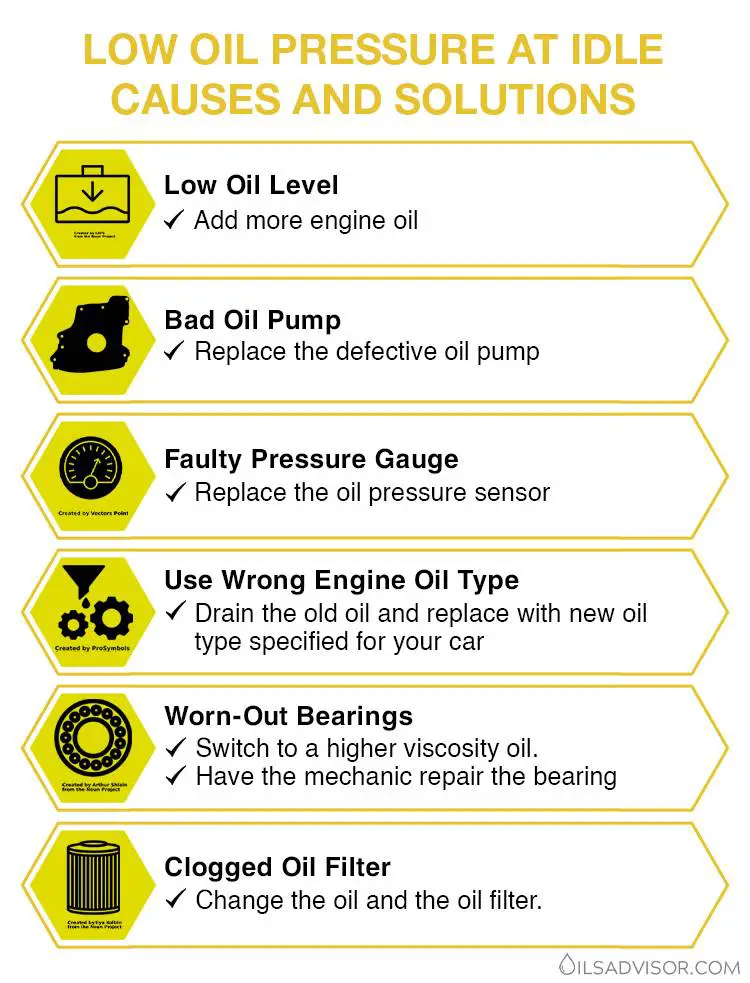
Low Oil Level
Low oil level is one of the most common causes of low oil pressure at idle. When the oil level in your engine is low, it becomes more difficult for the oil pump to maintain regular oil pressure. A crucial step to take is checking your engine oil level on a regular basis.
How to detect
The first sign is the illumination of a warning light on your dashboard. This warning light is connected to the systems that monitor your engine oil level. When the level falls below the standard mark, this light will illuminate to alert you. Furthermore, while driving, you may hear unusual noises such as knocking, clouding, or grinding. These sounds are caused by inadequate oil to lubricate engine parts and components.
If you want to be certain that you have a low oil level, you can check your oil dipstick to know. Park your car on the ground to check the oil level. With most cars, you need to turn off the engine. However, some car manufacturers recommend checking the oil after the engine has been warmed up. Check your owner’s manual for the proper information before doing any maintenance.
Open the hood and locate the oil dipstick. It usually has a yellow color. Pull out the dipstick and wipe it on a clean rag. Then insert it back and pull it again to read the oil level. Read both sides of the dipstick. If the level is below the minimum or low mark, you need to top it up immediately.
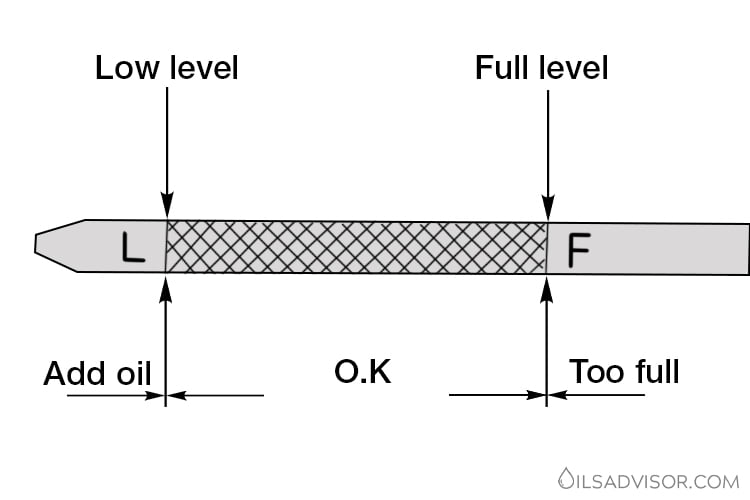
How to fix
To resolve this issue, check and keep your engine oil topped up regularly. You should only use engine oils that meet the specifications advised by your manufacturer. Here’s the step-by-step guide to adding engine oil
Step 1: Open the car hood
The first thing that needs to be done is to open the hood of the car and find the engine compartment.
Step 2: Locate the oil cap
Once the hood is open, you will see a big round or hexagonal cap almost in the middle of the engine compartment. That is where you need to pour oil into. Many oil caps will also have the type of engine oil required for your car on it. If not, you can check your owner’s manual to use the right type.
Step 3: Pour the new engine oil
Once you find the oil cap, remove it and make sure to wipe away any dirt or dust that may be on the cap. Then, use a funnel to slowly pour the oil into the tube. If you don’t know how much is enough, add a little at a time. Check the dipstick after addition to ensure that you don’t overfill. Wait for some minutes to let the oil reach every part of the engine then check it again. If the oil level is between min and max marks, then it is good to go.
Step 4: Put the oil cap back on
Once you are done pouring, put the oil cap back on
Read more: AT Oil Temp: Meaning, Causes, and Repair Guide
A Defective Oil Pump
The oil pump’s purpose is to circulate the oil throughout the system. This enables appropriate lubrication of moving parts and keeps the engine’s metal components from making contact with each other. The oil pump also helps regulate oil pressure.
A faulty oil pump is incapable of producing the required pressure to regulate the flow of oil through the engine. This means that the oil pressure of the engine will begin to fall. As a result, lubrication is reduced, allowing engine components to rub against one another and resulting in physical damage.
How to detect
If the oil pressure light illuminates on your dashboard, your oil pump may be faulty. Check the level of oil in your engine to confirm this. If you discover the oil level is low, top it up until the oil reaches the full mark. If your oil pressure remains low following this procedure, the oil pump is likely faulty.
Other symptoms that you should notice are noises and high engine operating temperature. If your oil pump doesn’t work properly, it will lose the ability to pump oil through the system and increase the friction on the parts and components. This will begin to make some whining or whirring sounds and increase the temperature.
How to fix
Replace the defective oil pump as soon as possible with a new one. This process requires advanced skills so I recommend taking your vehicle to a reputable mechanic. The cost for an oil pump replacement will be from $300 to $600 depending on your car’s make and model. A new oil pump will be around $100 to $300. Meanwhile, the labor cost will run around $150 to $300.
Faulty Pressure Gauge
A malfunctioning pressure gauge might produce low oil pressure at idle. The pressure gauge is quite important in your vehicle. Its primary function is to monitor the oil pressure in the car and inform you when it falls outside of the specified range.
A faulty pressure gauge will result in an erroneous oil pressure level reading and cause the warning light to illuminate. As a result, you will not be able to notice if there’s an actual oil issue in your engine. This jeopardizes the safety of you and your vehicle.
How to detect
You can easily detect this when your pressure light turns on indicating an abnormality in the oil pressure. If you are driving an old car, it has a mechanical gauge to calculate the oil pressure. If the oil level is good but the gauge shows zero, you have a faulty oil pressure sensor. For those who are driving modern vehicles, the oil pressure is probably electronic. If the sensor is not working properly, you will notice strange readings or it will sit on zero or full.
Moreover, when you hear a metallic sound coming from your engine but your oil pressure light isn’t on, it could be due to a defective oil pressure gauge.
How to fix
Contact a qualified technician to have the oil pressure tested with a gauge. If the pressure is normal, simply replace the oil pressure sensor.
How to replace an oil pressure sensor? The following step-by-step guide from this video will give you an idea of how to perform the job:
Use Wrong Engine Oil Type
Each car manufacturer has stated the type and viscosity to be used for their specific vehicle and engine. It is critical to adhere to these guidelines because incorrect viscosity can affect your oil pressure.
A lower viscosity oil has less resistance to flow resulting in low oil pressure. A higher viscosity oil may cause greater resistance, which leads to poor engine lubrication and, as a result, low pressure.
How to detect
Examine parameters such as the viscosity of the OEM-recommended lubricant and operating temperatures. When you use the wrong engine oil for your car, you might notice some symptoms below
- Your car could not start in cold temperatures.
This happens when you use higher viscosity oil than recommended. Too thick oil can’t lubricate parts in the engine properly and also affects the ignition process.
- Burned smell from your engine
If you use low viscosity oil, it will cause a burned smell from your engine. In extreme conditions, too thin oil can be broken down. This makes the oil unable to lubricate the engine effectively and increases friction and heat of engine parts. The overheating engine can reveal a strange odor when you are driving.
- Poor fuel economy
The most common you might notice when using the wrong engine oil is the poor fuel economy. If you suddenly recognize that your vehicle needs to be refueled more frequently, you might use higher viscosity oil than recommended. When the oil is too thick, your engine will work harder and consume more fuel than usual.
Read more: Marvel Mystery Oil Good Or Bad
How to fix
To resolve this issue, you must replace your engine oil quickly and correctly. Check your owner’s manual to see what’s ideal for your engine. After you pick the right oil for your car, simply drain out the old oil in the system and fill it with a new oil type.
Worn-Out Bearings
When a bearing is worn out, you may observe indicators of reduced oil pressure.
The small spaces between the wear surfaces that allow oil to flow through become larger and the bearing clearance increases as well. The increased bearing clearance allows oil to flow more quickly, lowering the oil pressure.
How to detect
A pressure gauge might be used to confirm the diagnosis. If the oil pressure at idle is too low, it may suggest that the engine bearing is worn out.
How to fix
One way to fix this problem is to switch to a higher viscosity oil. If you are currently using 5W-20, you can switch to 10W-30.
Another approach for resolving the oil pressure issue is repairing the bearings.
Either of these solutions will lower clearance and restore the oil pressure.
Clogged Oil Filter
Another typical cause of low oil pressure is a clogged oil filter. A clogged filter prevents oil from flowing freely, reducing the oil pressure level and activating the warning light. The filter’s purpose is to remove any contaminants or dirt from your engine oil. However, as the filter absorbs more dirt and contaminants, it may become clogged and stop working properly.
When the filter becomes clogged with contaminants and the bypass valve underperforms, the lubrication will be reduced, leading to low oil pressure.
How to detect
Engine check lights, metallic noise from moving parts, dark exhaust smoke, and poor engine performance are all indicators that your oil filter is clogged. Sputtering is another sign of a clogged oil filter.
How to fix
To resolve this issue, you must change the oil and the oil filter. Follow the step-by-step guide below to do this maintenance process.
How To Change Your Oil And Filter
- Step 1: Warm up your car
Start your car and let it run for some minutes. This helps warm up the engine oil and allows it to drain easily.
- Step 2: Drain the old oil
Jack up your car by the jack stand and locate the drain plug underneath. Once you identify the drain valve, place the oil pan on a newspaper. Use the socket wrench to loosen the drain plug, turning it anticlockwise. Then, slowly remove the drain valve by hand and let them drain out. When the old oil slows to a drip, reinstall the drain plug and tighten it with the wrench.
Caution: The oil can be hot.
- Step 3: Replace the oil filter
Locate the oil filter and loosen it with the filter wrench and remove it by hand.
- Step 4: Install the new oil filter
Note: Apply a little oil to the new gasket to prevent it from cracking, sticking, or causing an oil leak.
Install and tighten the new filter. Spin it clockwise till you feel it stops turning.
- Step 5: Add new engine oil
Open the oil cap and use a funnel to slowly pour the new oil into the tank. Once finished, replace the cap and tighten it securely.
- Step 6: Start your car
Start your car for a while and then turn it off and check the oil dipstick. If the oil level is between min and max marks, then you are done.
Read more: Purolator Oil Filter Review
How Much Does It Cost To Fix Low Oil Pressure
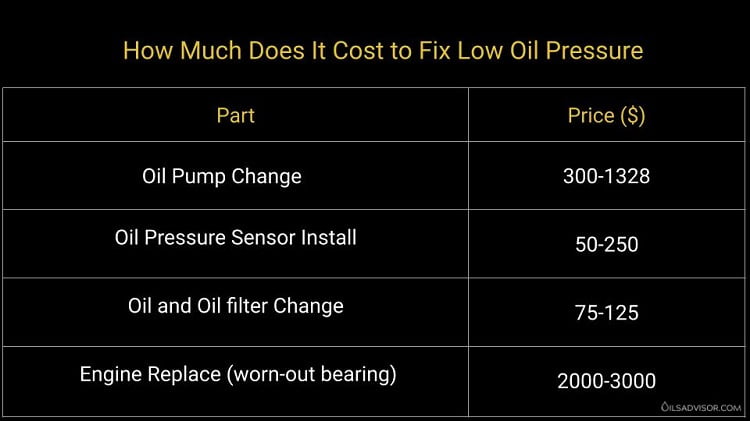
The repair may be pricey, depending on the problem and what needs to be replaced.
The cost of replacing an oil pump can range from $300 to $1,328, depending on the vehicle and the shop. The average cost of installing an oil pressure sensor ranges between $50 and $250, depending on the vehicle model and labor expenses.
A regular oil and filter change will often cost between $35 and $75. If your engine requires synthetic oil, you’ll probably pay up to $125 for it. The cost of replacing the entire engine assembly for a worn-out bearing, including labor and materials, will be roughly $2000-3000. You may need to consult with a professional technician to determine the actual cost of your vehicle.
Conclusion
Oil plays an important role in keeping your engine and its parts lubricated. When the oil pressure is low, it indicates something is not working properly. If you notice that your oil pressure has dipped below what should be normal for your vehicle, diagnose the issue and fix it before it becomes a significant problem.
Always maintain a routine oil change and follow manufacturer’s recommendations for regular maintenance to ensure optimal performance of your car’s engine components!
Have you ever experienced this problem? Could you share with us in the comment box below?
Related Reads
- 5.3 Common Oil Leaks: Cause & Repair Guide Discover how oil leaks can lead to low oil pressure at idle and how to address these common issues – Learn more.
- Coolant Boiling In Reservoir: Causes & Solutions Explore how issues like coolant boiling in the reservoir can be related to low oil pressure at idle and their solutions – Find out more.
- Marvel Mystery Oil Review Learn how using Marvel Mystery Oil can help prevent and resolve low oil pressure problems in your engine – Explore here.
- Unparalleled Penetrating Oils for Rusted Nuts and Bolts Discover how maintaining proper lubrication with the right penetrating oils can prevent low oil pressure at idle – Discover now.
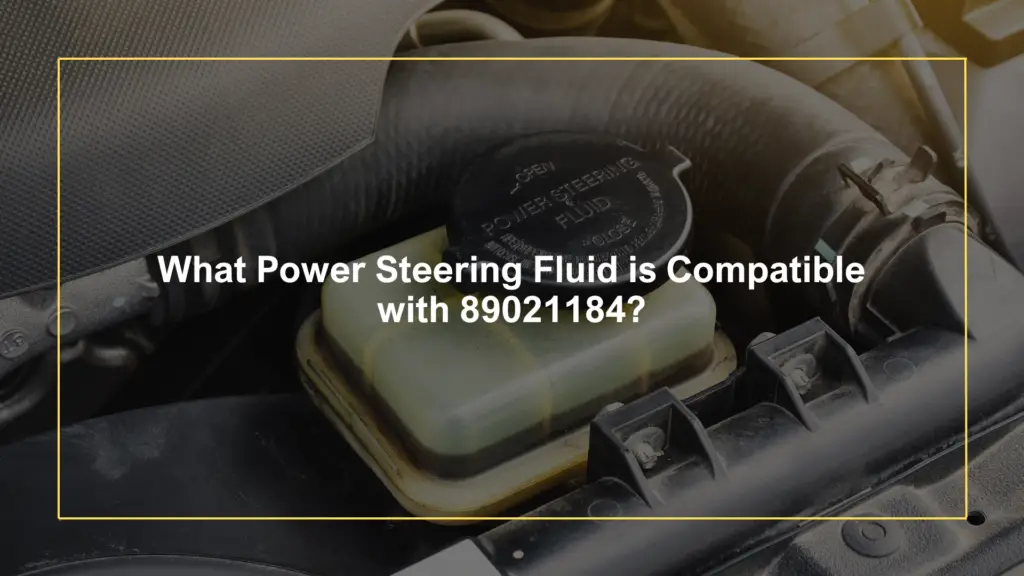
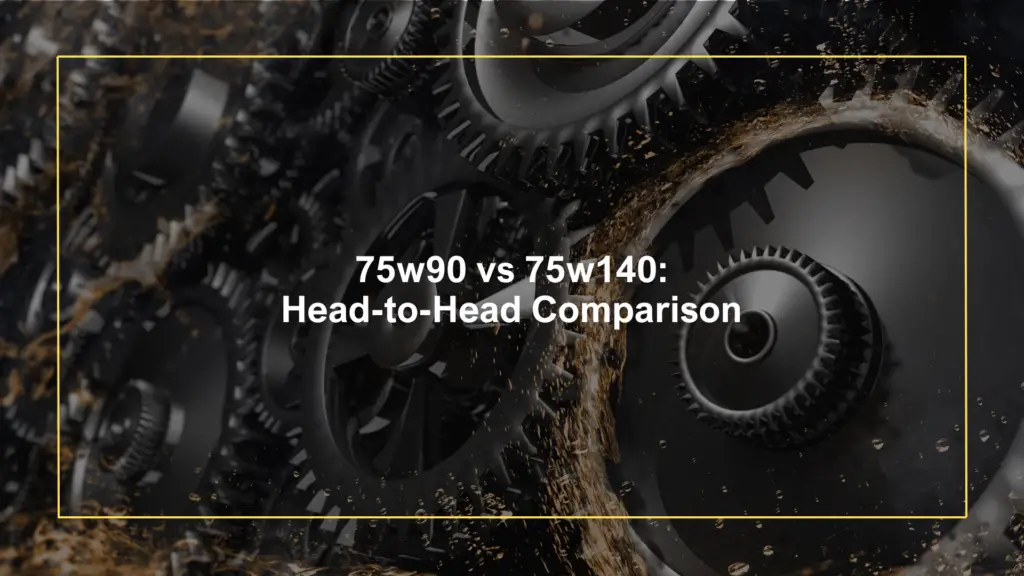
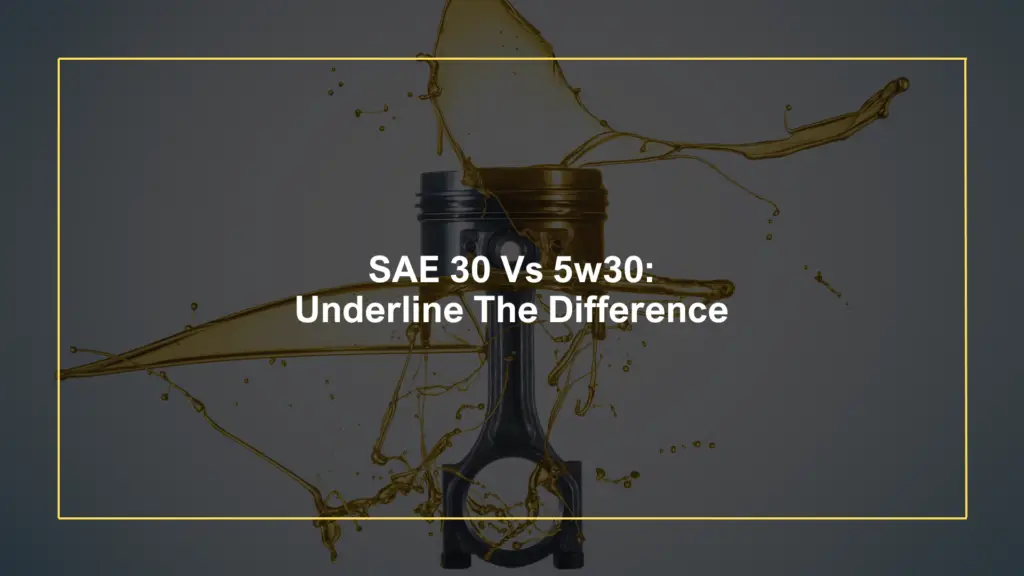
Pingback: AT Oil Temp: Meaning, Causes, and Repair Guide - Oils Advisor
Pingback: All You Need To Know About Differential Fluid Change - Oils Advisor